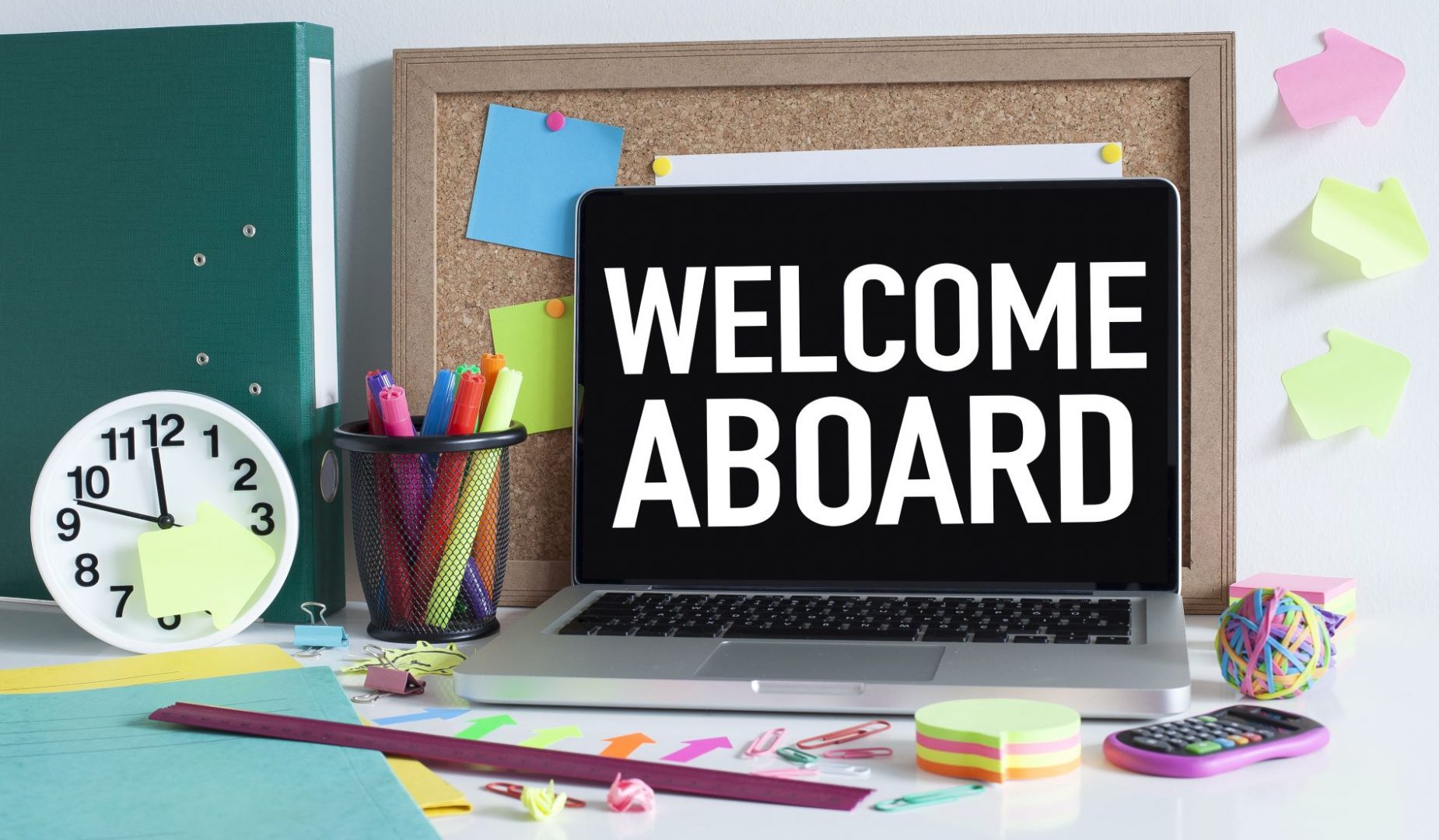Tips To Create a Successful New Employee Orientation
The process of hiring new staff can be time-consuming and arduous. Recruiting the right talent for the job takes dedication to the hiring process, but what about after they’re hired? Once you’ve identified a candidate who is a great fit for your organization, you’ll have to onboard them in a way that is engaging, and exciting for them. While simultaneously delivering clear messaging about the policies and procedures at your company.
It’s a delicate balance to both keep your new hires excited and inform them of administrative policies that they’ll need to know. There’s nothing quite like killing a new hire’s excitement for their new role by offering a dull and overwhelming first few days through boring employee orientation processes and long webinars that put them to sleep.
Luckily, there are ways in which you can engage with your new staff and keep their enthusiasm high. In this guide, we’ll discuss what exactly an employee orientation is and how it differs from — or complements — the onboarding process. We’ll discuss best practices and fun ideas for employee orientations that are innovative and interactive. And finally, we’ll give you the tools you need to succeed in developing your own new employee orientation.
What Is New Employee Orientation?
Many people think that employee orientation is the onboarding process. But this isn’t true, your employee orientation is only a small part of the entire onboarding process. The onboarding process consists of filling out forms, introducing staff to each other, working with HR to get benefits in order, and a lot of other tasks depending on the type of organization you operate.
Your new employee orientation is typically a presentation or interactive course for your new hires to get acquainted with the company culture as well as the policies and procedures you have in place.
Employee orientation often gives employees a birds-eye view of the company. Sometimes it may include an introduction from the CEO or other times, it’ll be a meet and greet for all of the new staff, either way, your employee orientation is a great opportunity to set the tone of your work environment.
What to Include in Your Employee Orientation
So what needs to be included? We’ve created a new employee orientation checklist to help you prepare exceptional orientations for your staff. We encourage you to infuse your own brand and culture into this checklist, what are some ways in which you can add your unique culture to the items on the list?
1. Your Brand, Mission, Vision, and Values
It’s best practice to start your employee orientation with your company’s mission, vision, and values. This sets the tone for the rest of the presentation. You can include your company’s history, information about the founder or current leadership, as well as discuss the vision you’d like to see the company achieve.
Your values are another big selling point for new hires. It’s likely that they’ve already researched your company and found some alignment with your values to their own. This is a good reminder to talk about the values you have as an organization and provide examples of how you infuse them into your operations, marketing, and programs.
Some examples of how you implement your values could be showcasing a current employee and their work with a client and customer. Detail how they exemplified the company’s values and discuss how it develops your positive and collaborative company culture.
2. Introduction to Your Operations and Organizational Chart
After your mission statement and discussion on vision and values, it’s suggested to have a high-level overview of your current organizational chart. If your new employee orientation consists of interdepartmental new hires, then this can be helpful to see how they relate and connect to their colleagues.
Bring in other team members outside of HR to discuss their roles and responsibilities within the organization. If you have a marketing team that works across departments, have them introduce themselves and describe how they support other department goals.
Map out ways in which your employees work together and who they should report to if they have specific inquiries or questions that need to be answered.
3. Administrative Policies & Procedures
Probably the least fun part of the whole presentation, but a necessary one. Every company has its own unique policies and procedures. If your team needs to learn how to report their time to management, this is a perfect opportunity to discuss that process.
You’ll also need to go over certain policies around reporting employee misconduct and all the not-so-fun things to discuss during the onboarding process. Everyone knows this is necessary and expects it to be included in the orientation, but that doesn’t mean it has to be boring.
Go over high-level details in the employee handbook, instead of going through the entire handbook, just point your new hires in the direction of where they can find it. Using tools like the Bites app can actually make employee handbook reviewal less overwhelming, by offering bite-size chunks of information at their own pace.
4. Benefits, Paid Time Off, Etc.
Your employee orientation program also typically covers the benefits package you offer. Many new hires will understand the high-level benefits packages that are available to them, but this can be a good opportunity to dive deeper into certain policies and benefits they may not have asked about in the interview process.
Here are some benefits that you may include in your employee orientation process:
- Health, Dental, and Vision benefits
- Paid Time Off and Holiday Pay
- Sick Leave and Disability
- Parental Leave Benefits and Policies
- Educational benefits and programs your employees can enroll in.
- Childcare subsidies, if applicable
- Health and wellness opportunities for staff
- Remote work policies and procedures
- Additional benefits could include sabbaticals, reimbursements, and travel.
5. Department Specific Information
If you’re a larger company and deliver employee orientation by department, then you can add more specific information about the department they’re working within. Conversely, if you’re a midsize company, you may want to introduce your new team to all the departments within the company.
Introduce them to department heads and give the presenter an opportunity to talk more about their department within the company and how their work informs the success of the department.
Want to learn more? Let’s chat!
Fun New Employee Orientation Ideas
Who said employee orientation had to be a drag? Instead, it can be a great time to connect and learn more about your new team members. While nearly every employee orientation will have to include some form of administrative information, you can still make the orientation an exciting part of your overall onboarding process.
It’s proven that even one new hire can offset the company culture, so starting out on the right foot is crucial in both the new hire’s retention and the preservation of your organizational culture.
1. Welcome Them With A Gift
Instead of crowding them around in a boring beige office, gather them in a cool spot. If your office doesn’t offer this, you can have an offsite meeting at a coworking space or other beautiful event space. If you’re looking to do this remote, then send your employees a nice welcome gift.
Some ideas for welcome gifts could include:
- A swag bag of your branded items like coffee mugs, YETI tumblers, or laptop bags.
- A gift card to a local coffee shop — or Starbucks
- A handwritten note welcoming them to the team
- Exclusive deals for your team members to local shops and restaurants
2. Use an App Like Bites to Deliver Your Orientation
You don’t have to use a regular, boring presentation for your orientation program. Instead, invest in technology that can help you grow as a company and as an employer. Tools like Bites, allow you to connect with employees in real-time as well as offer them snackable content that is easily digestible and able to be consumed at their own pace.
Think outside of the typical webinar or Powerpoint presentation and implement new technologies that connect with your employees. With the tool, you can send quick updates to employees, as well as invite them to watch detailed, prepared training and onboarding videos like your employee orientation presentation.
3. Invite them to a New Hire Summit or Conference
Another way to create enthusiasm and excitement around the onboarding process is to create a day (or week) around your newly hired talent. If you’re a larger company, invest in a new hire conference or summit. If you have employees around the country, invite them in to join in on a few days of presentations and activities.
Adopting a new hire summit is a great tool to use is you have a lot of employees scattered through the country or globe. This can give them an opportunity to meet executive leadership, connect with other new hires, and learn more about the company in a greater, more engaging detail.
4. Have an (optional) New Hire Game or Activity Planned
Not every employee is going to jump at the opportunity to join in on an icebreaker or want to play a game of Softball. And that’s okay, have some optional games or activities for new hires to do without calling too much attention to them. Have them perform a scavenger hunt through their onboarding docs, or invite them out to a baseball game after their first week on the job.
There are a lot of different ways you can gamify the new hire and orientation process. Consider having quizzes (and rewards) at the end of your presentations. Make the rewards exciting, like a gift card or valuable piece of swag. A free pen isn’t an exciting reward.
5. Have an Offsite Lunch or Happy Hour
It’s best practice for an employee’s boss to take them out to lunch on the first day on the job. But this is a bit traditional. Invite them to a happy hour with other members of the team, so they can get a sense of how people interact and work together. It will feel much more comfortable with other employees at varying levels as opposed to a one-on-one with your boss.
Another important thing is to invite the new hire before the day-of. This way they can prepare for their new day. Some people are on-the-fly planners, but not everyone. If your employees have families and things to attend to outside of work, don’t assume they can drop everything and attend a happy hour. Plus, you run the risk of them feeling obligated, which can be cause for an unnecessary start.
6. Have Them Take a Personality Test
Personality tests are a great way for employers to understand how their employees work as an individual and as a team. Personality assessments are a great tool for employers, but they also are a great value-add for the employee.
Using certain personality assessments like the 16 Personality Types and StrengthsFinders can give individuals insight into how they perform best. This allows them to hone in their certain strengths and understand how others work as well.
Want to learn more? Let’s chat!
Conclusion
There’s no perfect new hire orientation template. Each will be unique to the organization that is conducting it. But there are best practices and creative ways to engage with your new employees. The orientation process is the first step in setting a strong foundation with your employees.
Your employee orientation process will differ from another’s, and that’s perfectly normal — and expected. But implementing some of the best practices discussed, as well as incorporating fun and innovative ideas is a surefire way to retain top talent and keep employees excited to work for you. Whether you’re welcoming them with a gift, or throwing a fun, interactive scavenger hunt, connecting with your employees from day one is a definite way to build a positive company culture.







